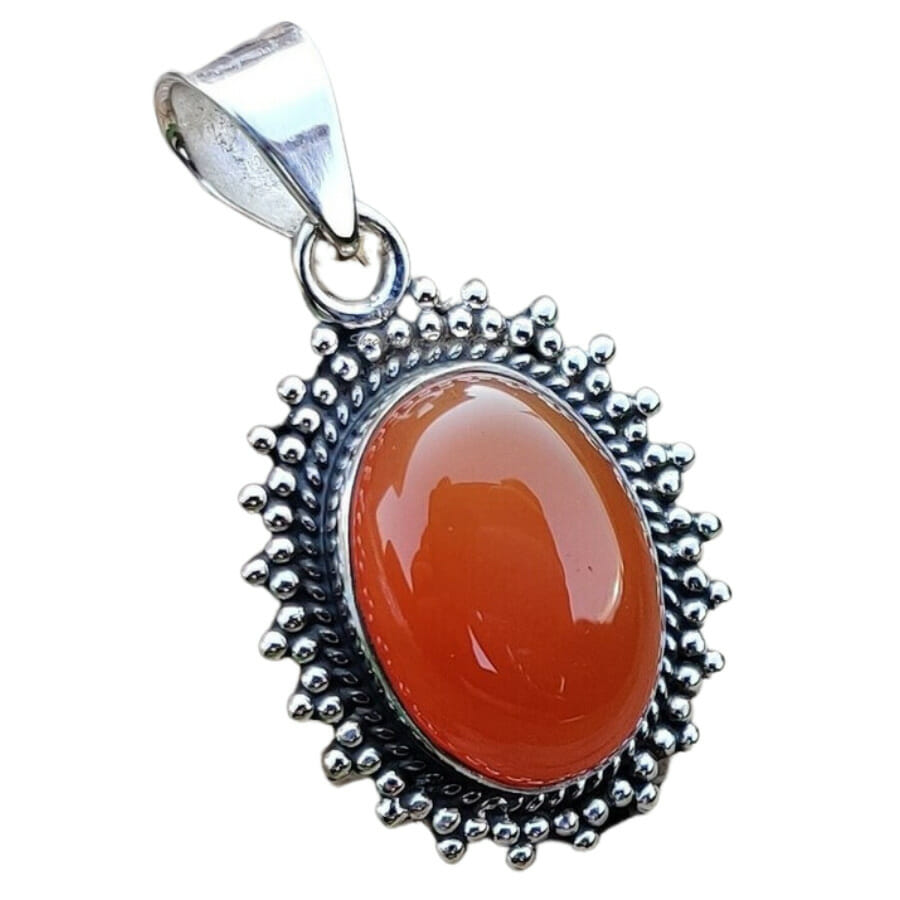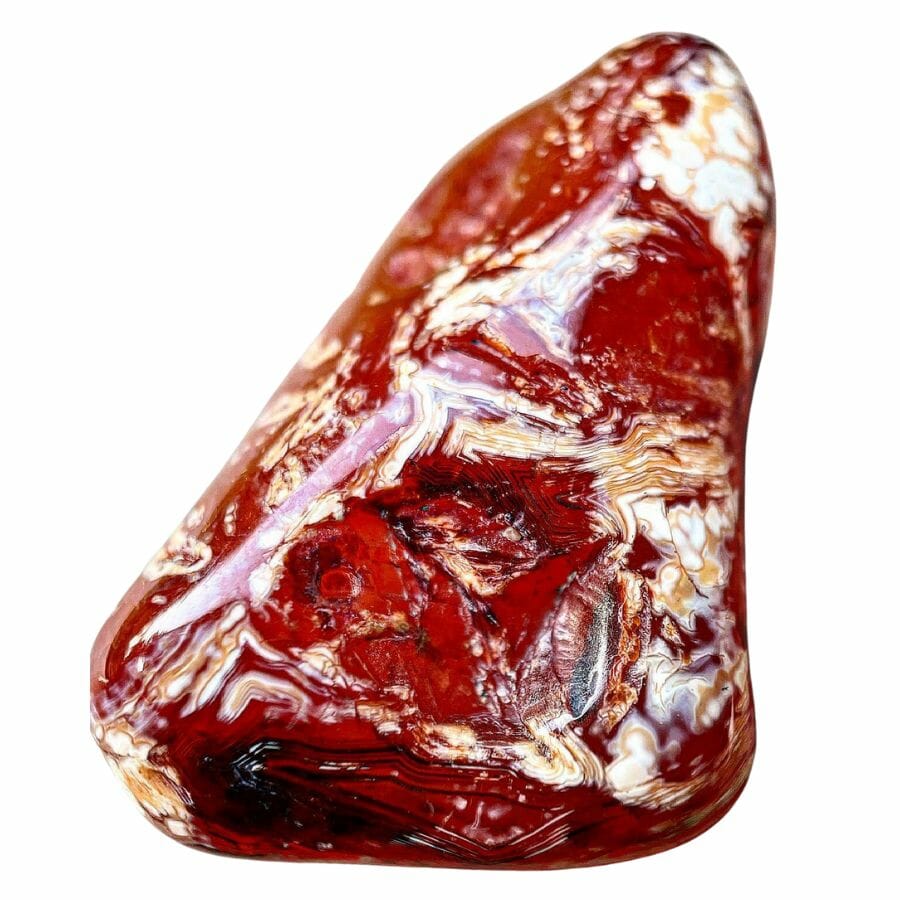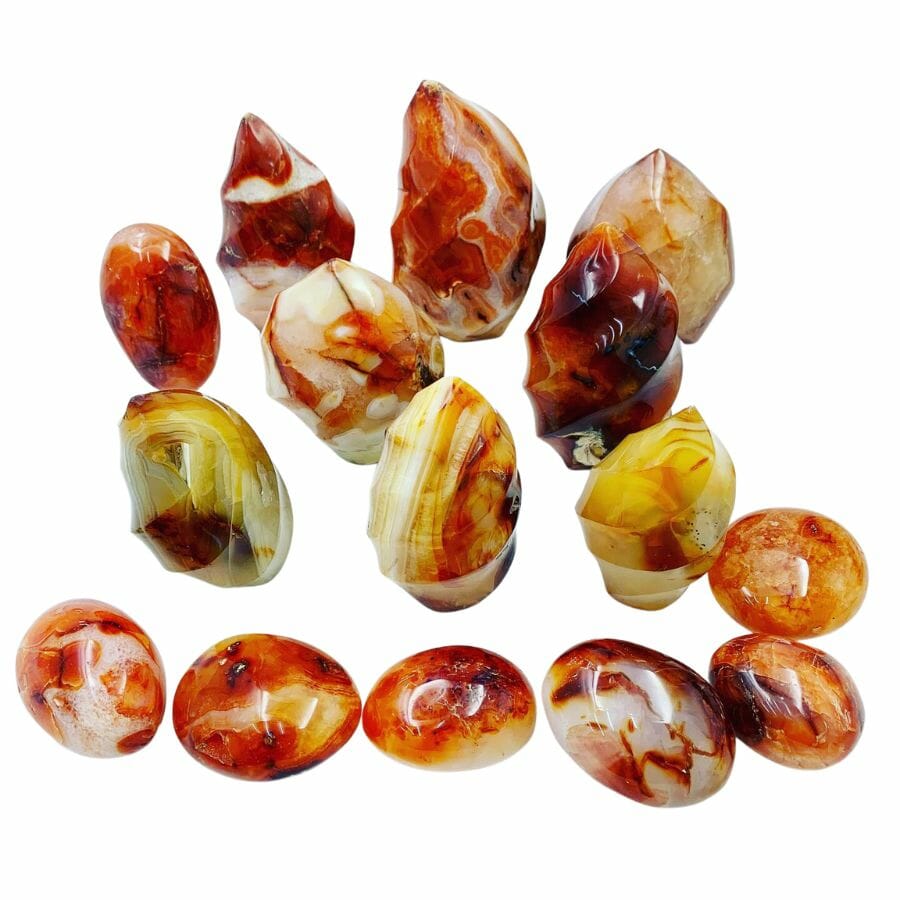We’re going to take a close look at two stunning stones: red agate and carnelian. They both have their own unique charm and stand out in any jewelry collection. Plus, they’re a hit among mineral collectors and rockhounds, too!
Let’s break down everything about these two stones, from color and crystal structure to where you can find these rocks in the wild. If you’re choosing a gem for your necklace and can’t decide, it’s a tough call between red agate vs carnelian because they’re both so cool-looking!
So whether you’re looking for your next necklace, adding to your rock collection, or planning your next rockhounding adventure, we can give you all the details you need. Let’s dive in and explore the fascinating worlds of red agate and carnelian!
Red Agate vs Carnelian – The Major Differences
When you’re trying to pick out a new stone for your collection, it’s always a fun challenge to figure out carnelian vs red agate because they’re both so unique! While they may seem similar at first glance, there are some cool differences between these two gems.
Appearance – Most carnelian pieces have clear and visible bands

Firstly, let’s focus on bands and patterns on these stones. These are one of the big clues you can use to tell the difference between red agate and carnelian.
First up, red agate. Sometimes, it has super clear bands that are hard to miss.
But here’s where it gets tricky. Red agate doesn’t always have bands like these.
Instead, it might have cloudy or foggy patterns. It could also be completely smooth and clear of any patterns on its surface.
Now, let’s talk about carnelian. Unlike its red agate cousin, carnelian almost always shows banding. Picture it like a cake, with lots of layers on top of each other. So if you see a stone with bands, it’s likely to be carnelian.
Keep in mind that while bands are a helpful clue, they’re not always foolproof. Even so, make sure to check out those bands and patterns!
Colors – Red agate has a deeper red color

Even without the bands or stripes, you can spot some differences between red agate and carnelian. One such difference is the color of these stones.
Red agate usually has a deeper red color, like the hot coals in a campfire. But it’s not always deep red! Sometimes, red agate likes to mix things up. You might see bright orange hues too, like the flames dancing above those hot coals.
Now, let’s talk about carnelian. This gem tends to lean more into a deep orange color, like a candle flame. But just like red agate, carnelian can surprise you. Sometimes, it can show off a deep red color, like a sunset at the end of a summer day.
Their colors are incredibly similar. But if you look at carnelian vs red agate side by side, you can see see the differences.
Luster – Carnelian has a waxy to resinous luster

Luster is basically how a rock or gem shines when light hits it. There’s a bit of a difference between red agate and carnelian when it comes to their luster.
Let’s start with red agate. Imagine a fresh, shiny apple. That’s what we call a waxy luster. It’s not too blindingly shiny, not too dull – just a soft, delicate shine.
Carnelian also has a waxy luster, but it sometimes kicks it up a notch and gets a resinous luster. It’s a bit like the glossy shine you’d see on an old-school piece of furniture that’s been polished to perfection.
It has a more intense shine, giving it an edge of boldness that red agate doesn’t quite have.
Crystal structure – Red agate has two types of crystal structure

Crystal structure is like the skeleton of a mineral, it’s how the little pieces – called atoms – are arranged. Think of it like building blocks in different shapes. Red agate and carnelian’s blocks are arranged differently.
First off, red agate. It’s kinda like a chameleon because it can have two types of crystal structures. It can be trigonal or monoclinic.
“Trigonal” describes crystals that are like stretched cubes – picture a diamond shape. “Monoclinic” describes crystals that are a bit weirder, kinda like a crooked box. So, red agate is pretty unique because it can be both!
On the flip side, carnelian keeps it simple. Its crystals are always trigonal, so it’s always diamond-shaped, just like one type of red agate.
Price – Carnelian tends to be more expensive

Now, let’s talk about the fun part – the price tag.
Red agate is like your best friend when you’re on a budget. It’s usually pretty easy on the wallet, which is great news if you’re looking to add to your collection without breaking the bank
The exact price can change a bit depending on the quality and size of the piece, so bigger and better-looking pieces might cost a bit more.
Now, if you’ve got a bit more cash to splash, carnelian could be your gem. It’s generally a bit pricier than red agate. If you’re after high-quality pieces or ones with really rich, vibrant colors, you might need to dig a bit deeper into your pockets.
You can check out what carnelian is worth these days with the help of our guide.
If you’re hunting for a bargain, red agate is your guy. But if you’re okay to spend a bit more for something really special, check out carnelian.
Location – Red agate is found in Brazil, China, India, and the US

Let’s talk about where you can find red agate and carnelian. If you’re a collector, you might always be on the lookout for the best rockhounding locations for your next big discovery!
You can find both of these stones all around the world, but there are some places where they’re more common.
Red agate shows up a lot in Brazil, China, and India. You can also find it in the United States, particularly in states like Idaho, Montana, Oregon, and Washington.
Now, let’s chat about carnelian. This stone shares some favorite spots with red agate, like Brazil and India. But carnelian also shows up in places like India, Indonesia, Uruguay, and Egypt.
In the US, carnelian shows up in Oregon, Washington, Tennessee, Connecticut, New Jersey, and Florida.
Just remember, even though these are the hotspots, these stones can turn up anywhere in the world. So, always keep your eyes peeled!
Carnelian vs Red Agate – The Similarities
These two gems are so similar from the inside to the outside, which is why they’re so hard to tell apart! Let’s look at all the things they have in common.
Hardness – Red agate and carnelian have an identical hardness

Red agate and carnelian are just about as tough as each other. They both fall between 6.5 and 7 on the Mohs hardness scale.
The Mohs scale is kind of like a report card for rocks. It tells us how hard and tough they are. Hardness can also affect the price of red agate and carnelian, as well as other minerals.
It’s pretty impressive for red agate and carnelian to score a 6.5 to 7. It means they’re harder than some everyday things like a piece of glass or a penny.
This means that they can resist some scratches and they won’t easily get all chipped or damaged.
Streak – Both minerals leave a white streak

On the outside, red agate and carnelian have these warm, eye-catching colors. But when they get scratched on a rough surface, they reveal their secret: their streak.
Streak is the color of a mineral when it’s powdered. It’s tested by scraping the mineral across a piece of unglazed porcelain called a streak plate.
This can help us identify minerals since the streak color doesn’t change, even if the mineral color does.
Picture this: you have a piece of red agate, and you scratch it on something rough, like a piece of unglazed ceramic. Despite its fiery outward colors, it leaves behind a white streak.
The same thing happens with carnelian. Even though it’s also got these warm tones on the outside, you’ll find a white streak too when you scratch it.
Cleavage – They both fracture instead of cleave

Red agate and carnelian don’t have what’s called cleavage, which refers to the way minerals break.
When you try to break a red agate, it doesn’t split into neat, flat pieces. It actually fractures, sort of like how glass breaks.
This is called a conchoidal fracture, and it’s a fancy way to say that the breakage looks kind of like the inside of a clamshell. It’s all curvy and rounded, not flat and straight.
Carnelian also lacks cleavage and breaks with a conchoidal fracture. So, instead of splitting neatly, it breaks into those curvy, clamshell-like pieces too.
Chemical composition – The two are made of silicon and oxygen

There’s a good reason why red agate and carnelian look so much alike: they’re actually made up of the same stuff.
Think of them as siblings. They’re both types of quartz, which means they’re both made of something called silicon dioxide.
What’s silicon dioxide? It’s actually just a combo of silicon and oxygen. Imagine them as tiny building blocks.
These blocks come together in a certain way to form quartz. Depending on a few things like temperature and pressure, you end up with either red agate or carnelian.
Density – Both stones have similar densities

Density is basically a measure of how much stuff is packed into a certain space. The density of red agate and carnelian is usually around 2.58 to 2.64 grams per cubic centimeter.
This tells us that these gems have a similar amount of matter in them.
Think of it like packing for a trip. If red agate and carnelian were suitcases, they’d both be packed with about the same amount of clothes, shoes, and other stuff.
Formation – Red agate and carnelian crystallize over a very long time

The way red agate and carnelian are formed is like an amazing science experiment by nature.
Both start out from something called silica-rich solutions. Imagine this as a liquid full of tiny bits of a material called silica. This stuff seeps into cavities in rocks or coats the surfaces of other rocks.
Then, the magic happens. Over time, all the silica in the solution starts to harden and crystallize. It’s kind of like how water turns into ice, but a whole lot slower.
This crystallization process takes years and years, slowly transforming the solution into a solid.
At the end of it all, you’ve got either a piece of red agate or carnelian.
Both these stones start out in the same way and go through the same process. It’s like they’re following the same recipe, but ending up with different but equally yummy dishes.
Have you ever thought about spending a sunny afternoon finding gems near you? It’s like a real-life treasure hunt! Knowing how these rocks form can help you find the best spots.
Magnetism – Neither one is magnetic

If you’ve ever played with magnets, you know that some things stick to them and some things don’t. Well, red agate and carnelian are very much not attracted to magnets.
Imagine you have either a red agate or a carnelian. Nothing would happen if you brought a magnet close to the stone. It just doesn’t have the right elements that would make it get all buddy-buddy with a magnet.
Fluorescence – They glow under UV light

One of the coolest things about minerals is that some of them can glow under a blacklight. Both red agate and carnelian can do this neat trick. This is called fluorescence.
Imagine you’re in a dark room with a piece of red agate and a blacklight. You switch on the blacklight, and suddenly the red agate lights up.
Carnelian can join this party too! If you take a piece of carnelian and put it under the blacklight, it will also light up and start glowing.
Conductivity – Neither mineral can conduct electricity

Things like metal wires are really good at carrying electrical current. But red agate and carnelian aren’t so good at it.
Think of electricity as a relay race, where the baton is the electrical charge. In good conductors, the baton gets passed smoothly and quickly from one runner to the next.
But red agate and carnelian are like runners who don’t quite get the hand-off right. This is because they don’t have enough free electrons, which are the tiny particles that carry the electrical charge, or the baton, so to speak.
So if red agate and carnelian were in the Electricity Olympics, they wouldn’t win the relay race.
The Easiest Ways to Tell Red Agate and Carnelian Apart
There are a few tricks you can use to figure out which one is which.
It’s important to remember, though, that these tips aren’t foolproof. Sometimes red agate and carnelian can be really hard to tell apart, especially if the stones have been treated or altered in any way.
If you’re still unsure, the best thing to do is to ask a gemologist, a scientist who studies gems. They’ve got the tools and the know-how to give you a definite answer.
But in the meantime, these tricks should give you a pretty good start in your gem detective work. So, happy hunting!
Look for deep red or red-orange hues

One of the biggest clues you have when you’re trying to tell red agate and carnelian apart is their color.
Let’s start with red agate. Think about the color you’d see in a dark cherry or a really ripe apple. It’s a deeper, darker red. That’s the color you usually see in red agate.
On the other hand, carnelian has a different vibe. Its color is more like orange-red. Picture the color of a beautiful sunset or the inside of a cantaloupe. It’s a warmer, more orangey red.
So while both stones are red, carnelian is typically a bit more on the orange side.
These subtle color differences can be a big help when you’re trying to tell these two stones apart. But remember, there can be variations in each stone. No two stones are alike, which is part of the fun of being a gemstone detective!
Check the patterns on the stone

Let’s talk about the fun, layered details in red agate and carnelian. Both stones can have these layers, kind of like a slice of layered cake. But here’s the thing– they don’t always show up the same way in both stones.
Picture red agate first. It can be a bit of a chameleon. Sometimes, it’ll show off those bands or stripes nicely and clearly. Other times, it might decide to keep its surface smooth with no banding or striping.
Sometimes, red can also have cloudy or wispy patterns. Imagine the swirls of cream in a cup of coffee or how fog looks when it’s drifting through trees.
Now, think about carnelian. It’s a bit more reliable when it comes to bands and stripes. More often than not, you’ll see those layered lines in a piece of carnelian, like the rings inside a tree trunk.
So, if you see a red stone with lots of clear stripes or bands, it might be a carnelian. If it’s more cloudy or free of any patterns, it’s more likely to be a red agate.

